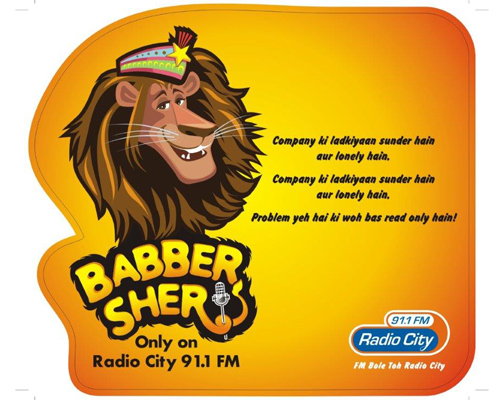

A comic, earthy roar
Laughter is, indeed, the best medicine. Look at all the Hindi GECs… Comedy shows abound and have always managed to attract eyeballs and attention in the marketplace. On FM, Comedy is one genre of content that shines forth whenever done and placed well amid the clutter of music, ads, RJ chatter and whathaveyou.
Last time, I wrote about RED FM's Mawali Bhai. This week, let’s look at one of the longest running and most easily recalled radio interstitial properties on private FM in India -- Babber Sher. This oldest funny interstitial has built the biggest brand equity for itself – after all, over a decade is a long time. But it wasn’t just the long time period it had to build itself; it has also been that Radio City’s programming team always managed to keep vaulting over the one hurdle that comedy always throws up at creative people. Ask any radio or television programming person, and they will tell you that comedy is always the most difficult genre to sustain. Having said that, the Radio City programming team has most often, managed to keep their Babber Sher’s roar a laugh-inducing one.

Whether through its main Urdu/Hindustani ‘sher’ or the earthy and often funny interjections of the very rustic audience, packaged with a dexterous baaja-peti lead tune, plus the dholak and the tooting auto rickshaw horn, Babber Sher – rechristened Radio City Babber Sher over a year back – continues to hit the sweet comic spot.
It is highest on unaided recall, and to my knowledge and belief, that has come not just from the longevity of the element and that critical element of consistent comic quality, it is also the result of some interesting marketing initiatives around the element. But before we come to those, let’s look at the history of Babber Sher.
I remember it first from my discussions with music programming expert Vikas Varma, who, way back in early 2004, if I recall correctly, was working on Radio City’s programming and its overall personality. He believed then, too, that an important element that could make the network instantly memorable, would be a good comic filler that could be a series.
Babber Sher had launched before Vikas came on to Radio City; however, he etched out the personality profiles of each of the characters in Babber Sher, to ensure consistency and longevity. Vikas, who went on to create such winners as 9XM, Hummra M and now Fata Fati and other top music channels, had then told me, “The earthy, humorous element that takes a leaf from the common man’s lingo and life – that can create a great magnet for the station.” In those days too, as it is today thanks to the regulatory restrictions on news on private FM radio, Radio City was not allowed to exploit the medium’s inherent immediacy and speed to emulate the internet as a news breaker; it remained and still is a purely music-driven station. Vikas believed that a large bell amongst the bells and whistles of its music programming would be that funny, chuckle-inducing element called Babber Sher, which had made its debut, but had yet to earn the tremendous equity it would later. And we know how quickly it caught the collective imagination. I know many regular FM listeners who would keep checking the station to catch the latest, angular, earthy shaayari of Babber Sher. I did that all the time. Still do.
Let’s look at the genesis of the element. Or no. First, let’s look at the element itself.
Babber Sher is a 2-odd-minute sparkler on Radio City 91.1 FM that starts with a signature tune followed, cleverly, by a lion’s growl. This is followed by a humorous two-line shaayari delivered by a crazy ‘shaayari mandali’ that has a harmonium played in the background and a man with a heavy north Indian accent reciting a sher with a punch line, of course. But before he can reach the punch line, our shaayar has to run the gauntlet of funny interjections from his equally earthy and persistent audience of listeners, who crack jokes at one another’s expense in the context of the shaayari our shaayar is trying to present. The content hooks are in the teaser first line of the shaayari (what will it lead to!); the comic banter and good-natured bonhomie amongst the listeners who are all spoiling to show off their own cleverness for a laugh at the expense of one of their companions; the main climax of the second line of the shaayari that is followed by another fun element -- a wisecrack as a sign off line, exemplifying truly lateral dehati thinking. Babber Sher has always been a strong comic sparkler of a property from Radio City with great recall value amongst the audience.
Those who have been watching MTV for around 14-15 years now will perhaps agree that Babber Sher, crafted for Radio City by one of the best names in comedy programming on television, Pankaj Saraswat, could well have been inspired by the shaayari-spouting Ismail Bhai, a popular, similar element created for MTV by Ram Vashisht. Ismail Bhai, a typical topi-rumaal-kurta-payjama-wearing qawwaal—looking shaayar, chewing and spitting paan and flanked by his cronies, used to hurl extremely earthy shaayari at one and all. But while Radio City’s Babber Sher has funny shaayari that is inherently gentle, Ismail Bhai, in keeping with MTV’s then apparently avowed mission to shock the world with bindaas stuff, came up with even slightly revolting stuff. Like in this element here:
Here are some more Ismail Bhai elements you can check out:
Babber Sher, though, is good clean fun shaayari. Like in this example here:
No hygiene issues there; Babber Sher doesn’t have even the occasional deviant episode. The shaayari is fun and simple, and if on rare occasion the lines might be a little flat and the humour a bit forced, the energetic mandali and audio packaging make it much better.
Over the years, Babber Sher has evolved subtly. Most private FM networks today are obsessed with the need to keep all the non-music elements of programming as brief and seamless as possible, and Babber Sher too has seen its most remarkable element, the signature title audio packaging, edited. I believe that a great part of the old Babber Sher element was the complete audio packaging -- the title or theme track, if you will -- which now has been edited and shortened. The original title track had a longer harmonium solo that the track dwelt on and allowed to grow into a very dexterous piece, at which point, a male voice exclaimed (at the wizardry of the harmonium playing) “Oh ho…! Maar hi daaloge!”, which was the perfect climax to the track.
Now, the harmonium solo has been reduced, and the intricate and difficult piece at the end has been left out. So, to my mind, the “Oh ho…! Maar hi daaloge!” exclamation is a bit disembodied. If you hadn’t heard the old packaging, you’d probably not miss the earlier element, but hey, this isn’t nit-picking – it just tells you how well I remember the well-loved element and all its nuances. As, perhaps, most people who’ve mainlined on it for years, do. However, Kartik Kalla, National Programming Head, Radio City 91.1 FM, tells me, “I don’t think the editing has really affected the sparkler in a negative way. In fact it has made the content a bit more crisp for our listeners.”
Another good part of the evolution of Babber Sher has been the much richer vein of the funny comments or interjections by the rustic shaayari mandali audience. Happily, the creative heads know just where to end the number of interjections, so that they don’t hinder the progression across the sher being recited.
So although this property has evolved with time, the basic creative soul of the concept – i.e. the main ingredients and the artists – have remained the same, and that, with strong creative supervision, has combined to create the USP of the property. Reciting new ‘Babber’ shers with punches that remain funny each day is a difficult ask, but the team achieves that for the most part. And the team that works on Radio City Babber Sher is Avadhesh Srivastava, Bhupesh Singh, Vijay Gupta, Rafi Warsi and Murari Thakur.
I remember some three years ago, Radio City’s head of marketing Satyanarayanan had shared with me an audio CD compilation of the best Babber Sher sparklers. It was a collector’s item, one that, regretfully, I have misplaced since.
Besides such content-driven collateral, the network generally does periodic campaigns for Babber Sher. As Kartik Kalla told me, “To celebrate a decade of Radio City Babber Sher, we had a huge marketing campaign. There was a special ‘Babber Sher ki Mehfil’ - a fun-filled shaayari contest that was arranged for the listeners. We also complied the best shaayaris in a special CD that was distributed to the trade fraternity. Special Babber Sher merchandise like coasters, book marks, key chains, mouse pads etc were made for the listeners.”
So, primarily through its own network, and also thanks to the marketing initiatives around Radio City Babber Sher, people from the Radio City markets and across the country and even internationally have followed Babber Sher through various mediums like YouTube, planetradiocity.com and more.
Though they’ve worked on syncing with the master audio track each ‘interjection and comment’ as graphic elements in split second timing on the YouTube video edit, even the simple audio track alone with just a Babber Sher bumper would have worked just as well. This is a truly audio-driven sparkler, obviously.
It can definitely be said that Babber Sher is the longest running feature in the history of the Indian private FM industry. It has been a trendsetter that inspired many other such properties that came and went. Today, if you ask anyone about the funnies on FM Radio, probably the first name they come up, especially if they’ve been listening to Private FM Radio for five years or more, now, would be Babber Sher. Followed, likely, and in no particular order, by BIG FM’s Actor Calling Actor, Red FM’s Mawali Bhai and Fever’s Charlie Chikna.
Next week, let’s look at another hilarious, excellent-mimicry-driven interstitial, Actor Calling Actor on BIG FM.